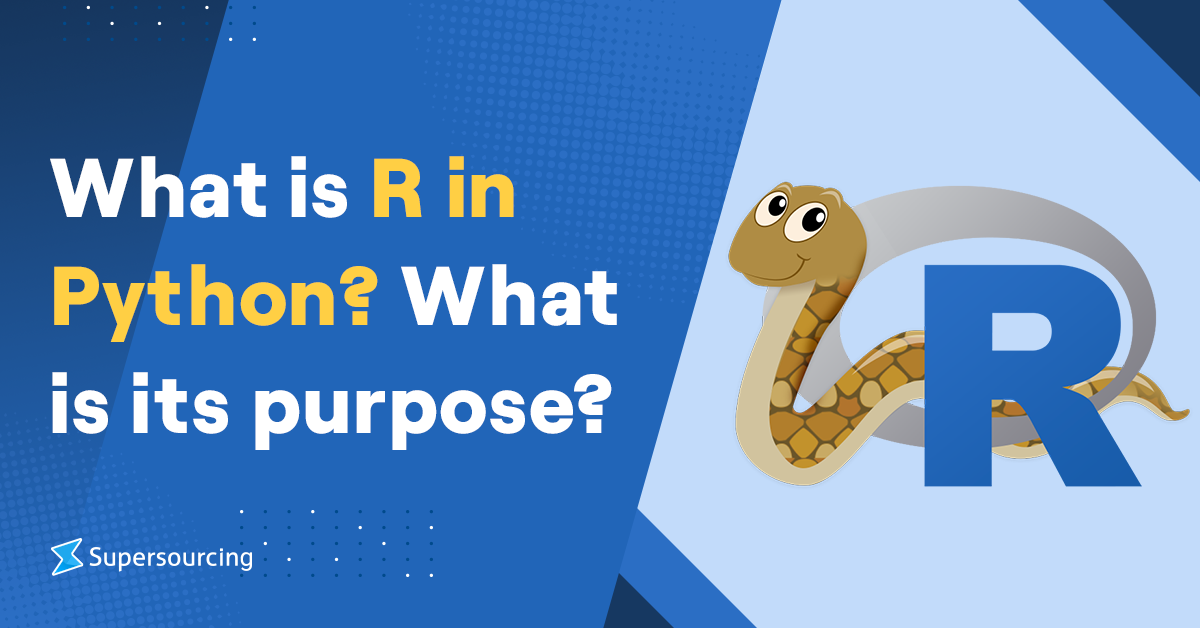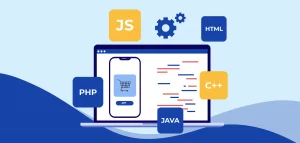Table of content
Python is a popular programming language that helps build applications such as website and software development, task automation, and data analysis. Especially if you’re working on AI/ML project, you’ll want to hire Python developers with high experience and skills.Although Python is a versatile language, there may be better choices for certain types of data analysis. This is where R, a language specifically designed for statistical computing and graphics, comes in.
So, if you are wondering what is R in Python, it is a language that complements Python for data analysis. The user-friendliness of Python has made it a preferred choice for beginners. The power of R makes it an excellent choice for experienced data analysts.
In a recent survey conducted by industry analysts, RedMonk, Python ranked as the second-most popular programming language among developers.
Why? Because of its ease of use, large community support, and many libraries and frameworks are available.
Python’s versatility allows it to have applications in various domains such as finance, education, healthcare, and scientific research. It enables web development, creating desktop applications, game development, and machine learning, among other things.
Python’s syntax is concise and easy to learn, making it accessible for beginners. Its dynamic typing and strong object-oriented design make it an excellent choice for experienced developers.
Python is a powerful, versatile, user-friendly programming language that caters to different programming needs. Its widespread usage and popularity among developers testify to its effectiveness in solving problems across various domains.
What is Python Used for?
Python has an endless list of uses. From data analysis and machine learning, web development, automation or scripting, to software testing, and prototyping. For data analysis, Python has become a popular choice for data scientists, allowing them to conduct complex statistical calculations, create data visualizations, build machine learning algorithms, manipulate and analyze data, and complete other data-related tasks.
In web development, Python commonly helps build the back-end of websites and applications. That includes tasks like processing data, communicating with databases, and ensuring security. Python offers several frameworks for web development, such as Django and Flask, and common web development jobs that use Python include back-end engineers, full-stack engineers, Python developers, software engineers, and DevOps engineers.
This framework is also helps developers with automation or scripting, where it can automate repetitive tasks, such as checking for errors across multiple files, executing simple math, or removing duplicates in data. Even beginners can use Python to automate simple tasks on the computer, such as renaming files or sending emails at specific intervals.
In software development, Python aids in tasks such as build control, bug tracking, and testing. Developers can automate testing for new products or features with Python, using tools like Green and Requestium. Python is also useful in everyday tasks, such as keeping track of stock market prices, sending text reminders, updating grocery lists, renaming batches of files, converting text files to spreadsheets, and even randomly assigning household chores.
What is R in Python?
In Python, the letter ‘r’ preceding a string signifies a ‘Raw String’. This instructs the Python interpreter to interpret backslashes in the string literally, rather than as escape characters, which is the default behavior. Using the ‘r’ prefix when defining a string is particularly helpful when you want to use a backslash as an actual backslash. Rather than as part of an escape sequence that represents something else within the string.
In Python, one can generate a raw string by placing the letter ‘r’ or ‘R’ before a string literal. Essentially, a raw string in Python will interpret the backslash character () as a literal character. This is opposed to an escape character which is the default behavior. This is particularly helpful in cases where a string requires a backslash, for instance in regular expressions or Windows directory paths, but should not be interpreted as an escape character. This article outlines the fundamental principles of how raw strings function in Python and offers a number of common examples demonstrating how to employ raw strings to include special characters within strings.
How Does Carriage Return “\r” Work in Python?
Many Python learners are familiar with the \n escape character in Python, which creates a new line. However, some may not be aware of the function of the \r carriage return in Python. In this article, we will explore what the carriage return “\r” does in Python.
A carriage return is a simple escape character that operates similarly to \n. However, unlike \n, which moves the cursor to a new line, \r shifts the cursor to the beginning of the current line. This means that when \r is used, any text following it will overwrite the text at the beginning of the line.
When \r is used, the text following it will be moved to the front of the current line and replace any characters already present one by one.. This is until all the content following the \r has been inserted. This makes \r particularly useful in situations where you want to update text in a single line of output, such as in a progress bar or other dynamic display.
In summary, while many Python learners may be familiar with the \n escape character, the \r carriage return can also be very useful. By shifting the cursor to the beginning of the current line, it allows you to update and overwrite text in a single line of output.
When to Use %r Instead of %s in Python?
In Python, when using the percent sign notation for string formatting, the %s specifier helps convert an object into a string using the str() method. On the contrary, the %r specifier converts it using the repr() method.
For some objects, such as integers, both %s and %r will yield the same result. However, the repr() method, for certain types, will return a result that is valid Python syntax. This means that the output could be used to recreate the original object unambiguously.
For example, when working with a string containing endline characters, using the %s specifier would display the text on new lines. The %r specifier would display the output as “\n” and keep the quotes intact. This is because the repr() method provides a string representation of the object that is explicitly valid Python code.
The general recommendation is to use the %s specifier for displaying objects as strings. This is unless you specifically require the extra detail provided by %r. The str() method will provide a string representation that is easy to read and understand. The repr() method is better for generating output that the system can use as input for the Python interpreter.
Why is Python Popular?
Python is a highly popular programming language due to its versatility and ease of use. The language employs a simple syntax that resembles natural language, which makes it easier to read and comprehend. Consequently, it becomes faster to build projects, debug and improve on them.
Another essential aspect that makes Python a popular language is its archive of modules and libraries. These modules & libraries have been created to expand its functionality. These modules and libraries help programmers execute complex tasks more easily and quickly. Furthermore, Python has a thriving and active community that continually contributes to its library of modules and libraries. It also provides help to other users when needed. The vast community support means that programmers can easily find solutions to any problems when using Python.
Conclusion
Python is an all-purpose language, allowing it to execute a diverse range of tasks, from web development to machine learning. Its application in different industries, from finance to healthcare, has increased its relevance in the tech space.
If you’re a developer looking to work for big tech companies, Supersourcing can help. Create your profile and provide us with all your details, and we will handle the rest!







